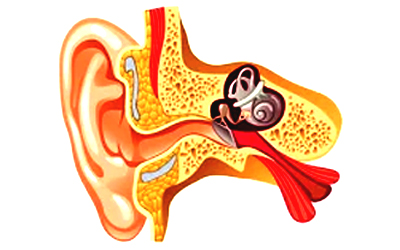Staepedectomy
A stapedectomy is surgery performed to restore your hearing and treat hearing loss caused by otosclerosis.

Some facts about Staepedectomy:
- Middle ear damage caused by otosclerosis can be repaired by Stapedectomies.
- In otosclerosis, your hearing gets affected by damaging your stape, a tiny U-shaped bone in your middle ear that sends sound waves to your inner ear.
- Your damaged stape ill be replaced with an artificial device by healthcare providers in a stapedectomy.
- A stapedectomy is required if you have hearing loss caused by otosclerosis.
- When your stape fuses with surrounding bone tissue, it loses the flexibility it needs to transmit sound waves from your middle ear to your inner ear causing otosclerosis.
- You may have trouble hearing low-pitched sounds or hearing people when they whisper if you have otosclerosis.

Preparation for Staepedectomy:
- Your hearing loss will be evaluated by your healthcare provider before you have a stapedectomy.
- Your medical history such as if you have tinnitus or vertigo and if you have a family history of otosclerosis will be asked.
- A physical examination will be conducted by your healthcare provider to check for acute or chronic ear infections.
- Your ear canals and your eardrum (tympanic membrane) will be examined.
- An audiometry will be performed to check your ability to hear a range of tones. The test results will be displayed in an audiogram.
- A tuning fork will be used to check your hearing loss and compare how well you hear sound through your bone and your ear. This can be done by tapping the tuning fork and putting it on your mastoid bone behind your ear and then your ear.
- Your eardrum will be checked with a handheld device called a tympanometer in a test called tympanometry. The test results will be displayed in a tympanogram.
- A computed tomography (CT) scan will be done by your healthcare provider to look at the bones and tissues in your ear.
Procedure for Staepedectomy:
- Usually, a Stapedectomies is performed as outpatient surgeries and last between 90 minutes to two hour.
- Anesthesia will be given, so that you won't have pain during the surgery. However, Stapedectomy can be done with local or general anesthesia.
- A laser or micro-instruments will be used by the healthcare provider to access your eardrum.
- Sometimes, a small incision will be made behind or in front of your ear to access your eardrum.
- Your eardrum will be lifted to reach your middle ear bones.
- Your stape will be removed and will be replaced with an artificial device.
- The surgeon will finish surgery by putting your eardrum back in place.
- Bandages or other material will be placed on your eardrum by the healthcare provider to hold it in place while your ear heals.
- A stapedectomy can be done in a middle ear with a congenitally fixed footplate to provide best outcome. However, the risk of hearing damage is greater than when the stapes bone is removed and replaced (for otosclerosis).
- A perilymphatic gusher may occur when the stapes is removed if high pressure within the fluid compartment that lies just below the stapes footplate exists.
- There is always concern of a perilymph fistula forming postoperatively, even without immediate complications during surgery.
- Stapedotomy, is a modified stapes operation that is considered as safer by many otologic surgeons. It reduces the chances of postoperative complications.
- A tiny hole is made in the footplate, either with a microdrill or with a laser and a prosthesis is placed to touch this area, instead of removing the whole stapes footplate.
- A tissue graft seal of the fenestra can be used to further improve this procedure.
- Laser stapedotomy is a surgical technique for treating conductive hearing loss due to otosclerosis in which a tiny opening will be created in the stapes to secure a prosthetic.
- A very small, precisely placed holes can be created by the surgeon without increasing the temperature of the inner ear fluid by more than one degree, whilst decreasing the risk of footplate fracture with CO2 laser.
- The size of the hole diameter can be predetermined according to the prosthesis diameter.
- Treatment can be completed in a single operation visit using anesthesia, followed by one or two nights' hospitalization.
Recovery from Staepedectomy:
- You may experience some mild pain or discomfort after your surgery. Over-the-counter pain medications can be prescribed to ease your post-surgery symptoms.
- You can go home once you recover from anesthesia.
- You will need to rest for the first few days after your surgery.
- It may take about six weeks to completely heal.
- Gently place cotton balls in your ear to absorb the discharge if you have some bloody discharge from your ear.
- Antibiotic drops may be prescribed for your ear to prevent infection.
- You will need to keep your ear dry. Put some Vaseline on a cotton ball and put the cotton ball in your ear if you take showers and gently pat your outside ear area dry after your shower to dry it.
- Flying in airplanes should be until your ear heals as flying puts pressure on your ear, and that pressure may dislodge your device.
- Use earbuds should be avoided until your ear heals.
Complications from Staepedectomy:
- Although most people gets benefit from a Staepedectomy surgery, your hearing may even be worse after surgery in rare instances.
- You may feeling dizzy immediately after your surgery and for the next few days.
- You may lose your sense of taste on the side of your tongue which typically goes away after a few months.
- You may developed tinnitus, or ringing in your ear.
- Additional surgery may be recommended if your hearing get worse after surgery.
- Using hearing aids may be recommended in some cases.
